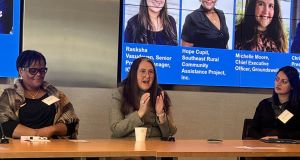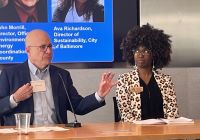Contact Us

Center for Environmental Policy Hosts Second Annual Inflation Reduction Act Symposium
On Thursday March 21, 2024, the Center for Environmental Policy (CEP) at American University’s School of Public Affairs hosted its second annual Inflation Reduction Act (IRA) symposium which focused on the role of local governments and communities at the frontlines of climate change. Speakers focused on the ways in which communities of all sizes and in all locations are working towards a clean energy transformation and climate resilience. The agenda is available here.
CEP Director Dan Fiorino opened the event and thanked project partners International City/County Management Association (ICMA), World Resources Institute and the Security and Sustainability Forum for their contributions. He also thanked ArentFox Schiff and Stanley Abramson for hosting the event, and American University’s Helfat Faculty Development Grant for their support. Danielle Miller Wagner, CEP’s Program Director, provided an overview of the agenda and introduced the keynote speaker, Tonantzin Carmona, Senior Advisor for Policy and Implementation at the Department of Treasury. Carmona focused her remarks on the important tool of elective pay that allows local governments and nonprofits to take advantage of IRA benefits quickly and with less red tape. She outlined the criteria and avenues for accessing federal tax credits using elective pay. View kaynote address.
In the plenary session, Ed Saltzberg of the Security and Sustainability Forum moderated a discussion with Dylan Reed of DOE’s Grid Deployment Office and Esther Sosa of EPA’s IRA Implementation Office. Sosa highlighted the Environmental Justice Thriving Communities Technical Assistance Centers (EJ TCTAC) which provide support for disfavored communities to gain access to federal funding opportunities. Dylan Reed shared his office’s objective to address threats to the electric grid, such as aging infrastructure and severe weather using $20 billion allocated via the IRA and the bipartisan infrastructure law.
 The panel session entitled, Hard to Reach Communities, was moderated by Raksha Vasudevan of ICMA, with speakers Michelle Moore of Groundswell, Hope Cupit of the Southeast Rural Community Assistance Project (SERCAP), and Christian Weaver of Grid Alternatives (GRID). Speakers highlighted how they are working to help remote, rural, and tribal communities make sustainable investments to advance energy reliability and climate resilience.
The panel session entitled, Hard to Reach Communities, was moderated by Raksha Vasudevan of ICMA, with speakers Michelle Moore of Groundswell, Hope Cupit of the Southeast Rural Community Assistance Project (SERCAP), and Christian Weaver of Grid Alternatives (GRID). Speakers highlighted how they are working to help remote, rural, and tribal communities make sustainable investments to advance energy reliability and climate resilience.
Moore highlighted Groundswell’s role in building community solar projects using the SOUL (Save On Utilities Long term) to provide residents with access to energy efficiency upgrades and improvements in housing quality. She also highlighted some of the ways in which Groundswell leverages a diverse funding sources such as those from USDA and EPA Community Development funding, as well as tools like tax credits and direct pay provisions to provide robust support to communities. Weaver talked about GRID’s history as the largest nonprofit solar installer in the US. He also discussed the importance of tribal energy sovereignty for self-determination and highlighted the Tribal Solar Accelerator Fund which has granted more than $3.2 million in solar and renewable energy projects to more than 20 tribal communities. In response to a question about her wish list to strengthen SERCAP’s delivery of resources and services to rural communities in the southeast US, Cupit shared that she would ask for uniformity across federal funding programs and common definitions for disadvantaged communities across the states to help implement the Justice 40 funding objectives. She indicated that the Climate and Environmental Justice Screening Tool has helped to harmonize definitions of disadvantaged communities, but there is more work needed in this area.
All of the panelists agreed that partnering with the federal government, academic institutions, nonprofits, and other stakeholders is critical to delivering funding and resources to the communities they serve.
 The final panel entitled, Urban Adaptation, examined the challenges facing urban communities and was moderated by Lacey Shaver of the World Resources Institute. Shaver was joined by Ava Richardson from the City of Baltimore, who discussed Baltimore’s 16 Resiliency Hubs which are being used to strengthen the ability of residents who have faced social and economic vulnerability to handle the impacts of climate change like extreme weather events. John Morrill of Fairfax County, Virginia, talked about the importance of strategic planning to prepare for the increasingly “hotter, wetter and weirder” conditions. To implement the county’s long-term plan, Morrill and his colleagues layer different resources and tools from federal and state agencies, utilities and others, to achieve various aspects of the plan to increase climate resilience and other complementary county priorities. Thomas Bartholomew of the District Department of Energy & Environment explained that DC’s Solar for All program works to provide solar energy to 100,000 low- and medium-income families.
The final panel entitled, Urban Adaptation, examined the challenges facing urban communities and was moderated by Lacey Shaver of the World Resources Institute. Shaver was joined by Ava Richardson from the City of Baltimore, who discussed Baltimore’s 16 Resiliency Hubs which are being used to strengthen the ability of residents who have faced social and economic vulnerability to handle the impacts of climate change like extreme weather events. John Morrill of Fairfax County, Virginia, talked about the importance of strategic planning to prepare for the increasingly “hotter, wetter and weirder” conditions. To implement the county’s long-term plan, Morrill and his colleagues layer different resources and tools from federal and state agencies, utilities and others, to achieve various aspects of the plan to increase climate resilience and other complementary county priorities. Thomas Bartholomew of the District Department of Energy & Environment explained that DC’s Solar for All program works to provide solar energy to 100,000 low- and medium-income families.
The panelists also discussed the various federal resources available to help strengthen urban climate resilience such as the Environmental Justice Mapping Tool, FEMA funds for renewable energy in Resilience Hubs, RGGI (Regional Greenhouse Gas Initiative) funds, Department of Transportation funds for transportation resilience projects and others. In closing, the panel discussed the differences in funding processes and leadership that add to the challenges facing all communities.
